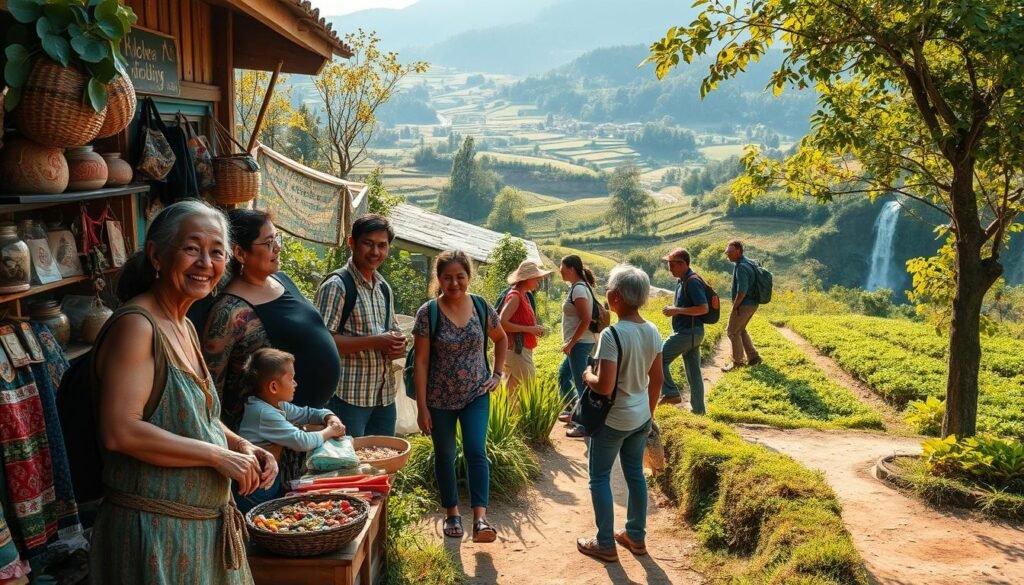Imagine diving into a new culture, living with a local family, and joining in on their traditions. This is what community-based tourism is all about. It lets local communities run their own tourism, giving them full control.
Sustainable travel is at the heart of community-based tourism. It lets visitors enjoy local experiences and help the local economy grow. Studies show that this way of traveling helps communities get more from tourism, making things fairer for everyone.
Key Takeaways
- Community-based tourism connects travelers with local cultures and economies.
- It promotes sustainable travel practices and local experiences.
- This form of tourism empowers local communities to control their tourism offerings.
- Tourists can engage in authentic cultural experiences while supporting local economies.
- Community-based tourism fosters a more equitable distribution of economic benefits.
What is Community-Based Tourism?
Community-based tourism connects travelers with local cultures and communities. It involves local communities in tourism activities. This way, everyone benefits equally.
Definition of Community-Based Tourism
It’s a tourism form where locals help plan and manage tourism. Studies show it boosts local economies and fosters cultural exchange. A tourism expert said,
“Community-based tourism is a powerful tool for sustainable development, allowing communities to benefit directly from tourism activities.”
This tourism focuses on sustainability and community involvement. It makes sure tourism is good for the environment and society. This helps the local community thrive.
Key Principles of Community-Based Tourism
The main principles are community participation, cultural sensitivity, and environmental sustainability. Community participation is key. It means locals have a big role in tourism planning.
- Community involvement in tourism planning
- Cultural exchange and preservation
- Environmental conservation
- Economic benefits for local communities
Following these principles, community-based tourism offers real experiences. It also supports the local economy and keeps cultural heritage alive. As responsible tourism grows, so does the value of community-based tourism.
The Benefits of Community-Based Tourism
Community-based tourism offers many benefits. It helps local economies and enriches cultural exchange for travelers. This tourism supports local economies and helps preserve cultural heritage.
Economic Advantages for Local Communities
Community-based tourism boosts local economies. Travelers support local businesses and artisans. This helps improve living standards and fund local projects.
- Job Creation: It creates jobs for locals, both directly and indirectly. This includes work in accommodations, food, and tours.
- Local Economic Stimulation: More tourists mean more spending. This growth encourages new businesses and services.
Cultural Exchange and Preservation
Cultural immersion tours offer real community interactions. Travelers learn about local customs and traditions. This enriches their experience and helps preserve cultural heritage.
Cultural preservation is supported by local artisans, events, and historical site care. This is funded by tourism revenue.
Enhancing Traveler Experiences
Travelers find community-based tourism more meaningful than traditional tours. They get to experience local life through homestays, tours, and workshops. This gives them a deeper understanding of the local culture.
- Homestays let travelers live with families, sharing meals and activities.
- Community-led tours offer insights into local customs and history. They use storytelling and interactive experiences.
How to Get Involved in Community-Based Tourism
Travelers can dive into authentic local cultures by choosing community-based tourism. This choice supports grassroots initiatives. It also makes the trip more meaningful and helps local communities grow.
Finding Authentic Community-Based Tours
To join in, look for tours that focus on local involvement and benefits. Choose tour operators that are open about their methods. They should be dedicated to ethical travel and responsible tourism. Websites focused on community-based tourism are great places to start.
Supporting Local Businesses and Artisans
Helping local businesses and artisans is key in community-based tourism. Buying local products and services boosts the local economy. This means staying in places owned by locals, eating at family-run spots, and buying crafts from artisans.
Here are some tips to support local businesses:
- Research local businesses and their offerings before traveling.
- Choose to eat at locally-owned restaurants instead of big chains.
- Buy handicrafts and local products instead of mass-made souvenirs.
By making these choices, travelers support responsible tourism. They help ensure tourism benefits everyone in the community.
Challenges Faced by Community-Based Tourism
Community-based tourism faces challenges like balancing economic gains with protecting the environment and culture. It’s key to tackle these issues to make sure tourism stays sustainable in the long run.
Balancing Growth and Sustainability
One big challenge is balancing growth with sustainability. More tourists can mean more money, but it can also harm the environment and local resources. To solve this, many places are using sustainable tourism practices to lessen the bad effects of tourism.
| Strategy | Description | Benefits |
|---|---|---|
| Eco-friendly accommodations | Using locally sourced materials and renewable energy | Reduced carbon footprint, supports local economy |
| Responsible tour operations | Guided tours that respect local environments and cultures | Enhanced traveler experience, preservation of local culture |
| Community engagement | Involving locals in tourism planning and decision-making | Increased community support, more authentic experiences |
Navigating Cultural Sensitivity
Another big challenge is navigating cultural sensitivity. With community-based tourism, travelers and locals interact closely. This can sometimes cause cultural misunderstandings or the misuse of local customs for tourist fun. To fix this, tour operators and visitors need to understand and respect local ways and traditions.
By being aware of these challenges and working to solve them, community-based tourism can keep benefiting both travelers and local communities. It promotes sustainable travel and eco-friendly trips.
Popular Destinations for Community-Based Tourism
From rural villages to urban centers, community-based tourism is changing how we travel. It lets us have authentic community interactions and enjoy local experiences. These are both enriching and memorable.
Rural Communities Embracing Tourism
Rural areas worldwide are welcoming community-based tourism. It helps their economies and keeps their culture alive. For example, in Panama, you can visit indigenous communities. There, you can join cultural immersion tours that show traditional life.
In Scotland, rural spots are welcoming visitors too. They offer local experiences like farm stays and craft workshops. These efforts boost the economy and keep cultural identity strong.
Urban Areas with Community-Focused Tours
Urban spots are also diving into community-based tourism. Many cities have community-focused tours that highlight unique neighborhoods. In Thailand, for instance, you can explore cities like Bangkok with local guides. They share insights into the lives of residents.
These urban tours focus on authentic community interactions. You can meet local artisans, street food vendors, and more. This way, you learn about the city’s culture and help the local economy.
In summary, community-based tourism offers many chances to connect with locals. Whether in rural or urban areas, choosing cultural immersion tours and supporting local businesses makes a difference. It positively impacts the places you visit.
Measuring the Impact of Community-Based Tourism
To make sure community-based tourism lasts, we need to check its effects on local areas. We look at how it helps the economy and improves social and cultural life.

Economic Indicators of Success
Looking at money matters is key to seeing if community-based tourism works. We see if more people have jobs, if local businesses grow, and if more money stays in the community. Responsible tourism makes sure everyone gets a fair share, improving life for all.
Some important signs of success are:
- More jobs in tourism
- More money for local businesses
- Better places to live and visit because of tourism
Social and Cultural Impacts
Community-based tourism also changes social and cultural scenes. It brings people together, helping them understand and respect each other. But, it can also make local culture seem like a product if not done right.
To avoid bad effects, we need to follow ethical travel rules. This means:
- Helping local artists and keeping cultural spots safe
- Letting locals show off their true way of life
- Keeping the environment safe for future visitors
By looking at both money and people impacts, we can make tourism better for everyone. It’s a way to make travel good for both visitors and the places they visit.
Success Stories in Community-Based Tourism
Community-based tourism is growing fast, bringing inspiring changes and benefits to many places. These stories show how tourism can help local communities and support sustainable travel.
A Village Transformed by Tourism
In Peru, the Ccaccaccollo community project is a shining example. It shows how tourism can help a community grow economically and share its culture.
“Community-based tourism has given us the chance to share our culture and traditions with visitors from around the world, enriching both our lives and theirs.”
What makes these projects work? A few key things stand out:
- Strong community involvement and decision-making
- Authentic cultural experiences for visitors
- Direct economic benefits to local households
- Environmental conservation efforts
Inspirational Projects Worth Noting
There are many more projects like this worldwide. They include community-led conservation, cultural preservation, and tourism cooperatives. These projects show the power of community-based tourism to make a difference.
| Project | Location | Impact |
|---|---|---|
| Ccaccaccollo Community Project | Peru | Economic growth, cultural exchange |
| Community-Led Conservation | Africa | Wildlife conservation, community development |
| Cultural Heritage Preservation | Europe | Preservation of historical sites, community engagement |
These stories highlight the importance of community-based tourism. They show how it can lead to sustainable travel and support local experiences. As tourism grows, we can expect even more inspiring projects to come.
Tips for Responsible Travel in Communities
Traveling responsibly in communities means thinking carefully about our impact. As responsible tourism becomes more important, people want to leave a good mark on the places they visit.
It’s key to be aware of cultural differences and traditions when interacting with local communities. Respecting local customs makes the trip better for everyone and builds strong bonds between visitors and locals.
Respecting Local Customs and Traditions
Knowing and respecting local customs is a big part of ethical travel. This means dressing right, joining in local traditions carefully, and knowing what’s considered proper.
- Learn a few basic phrases in the local language to show respect.
- Be mindful of your attire and dress modestly when required.
- Participate in local customs and traditions with an open mind.
Environmentally Friendly Practices
Choosing eco-friendly trips is essential to reduce travel’s environmental harm. Simple steps like using less plastic, saving water, and caring for wildlife can really help.
- Reduce your use of single-use plastics.
- Conserve water and energy in your accommodations.
- Respect local wildlife and their habitats.
By following these tips, travelers can help make community-based tourism sustainable. This ensures it keeps benefiting local communities.

The Future of Community-Based Tourism
The future of community-based tourism looks bright with new trends and tech. It’s key to know what will make it grow and change.
Community-based tourism is already helping with sustainable travel and local economies. It focuses on grassroots tourism. This way, communities get more from tourism, making things fairer.
Trends Shaping the Industry
Several trends will shape community-based tourism’s future. These include:
- Increased demand for experiential travel
- Growing importance of sustainability and eco-tourism
- Advancements in technology to enhance community engagement
- Rise of responsible travel practices
Travelers now want to travel in a way that’s good for the planet. This means more sustainable and responsible travel options. Tour operators are using eco-friendly methods and promoting cultural exchange.
Role of Technology in Community Engagement
Technology is key in making community-based tourism better. It connects travelers with locals through digital platforms and mobile apps. This helps tourists and locals meet and learn from each other.
Shivya Nath, a leader in this field, says tech will keep driving community-based tourism. Digital tools will help engage communities better, make travel more sustainable, and improve experiences for everyone.
| Trend | Impact on Community-Based Tourism |
|---|---|
| Increased use of technology | Enhanced community engagement and improved sustainability |
| Growing demand for sustainable travel | Increased adoption of eco-friendly practices |
| Rise of experiential travel | More meaningful interactions between travelers and local communities |
Looking ahead, community-based tourism will keep being important for sustainable travel and local support. By following trends and using tech, the industry will have a promising future for both travelers and locals.
How Travelers Can Promote Community Well-Being
Travelers can positively impact the communities they visit. By engaging in real community interactions, they can build strong bonds with locals. This promotes understanding and respect between different cultures.
Doing good deeds, like volunteering or supporting local shops, helps a lot. Taking part in cultural tours deepens the traveler’s appreciation for local ways of life. It also enriches the lives of those they meet.
Creating lasting connections with locals is easy. Just learn a few words in the local language or show real interest in their customs. These actions not only make the traveler’s trip better but also leave a positive mark on the community.
Ready to Plan Your Own Eco-Adventure?
Discover more sustainable travel destinations and tips to make your next journey both memorable and responsible.
Explore Eco Destinations
Discover Sustainable Tips













[…] June 23, 2025Community-Based Tourism: Connecting Travelers and LocalsImmerse yourself in community-… […]